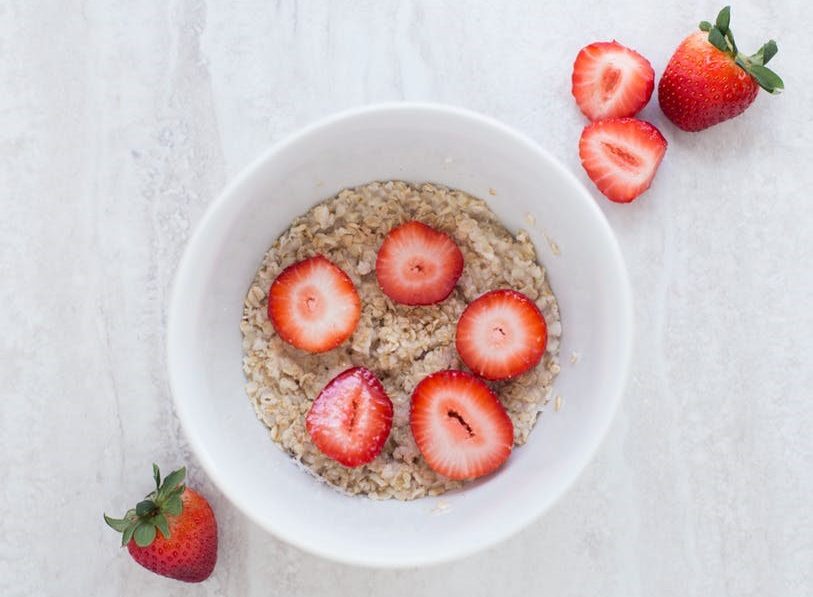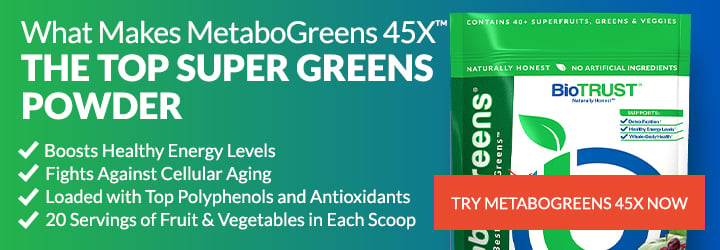16 Healthy Staples You Always NEED in Your Pantry

If you look in the average person’s pantry, what will you find? Well, in most, you’ll find a number of highly processed, sugary breakfast cereals, a few bags of chips and boxes of crackers, maybe some popcorn, and likely some packaged treats like cake mixes, cookies, marshmallows, and chocolate chips. Oh, and don’t forget the sodas.
No wonder one of the first things that’s recommended when we’re learning to eat healthier is to clean out the pantry and replace the high-calorie, heavily processed junk food with healthier options.
So, what foods make up a healthy pantry? What foods should you keep on hand to help you put together healthier meals easily? Here are our top 16 healthy (and often cheap) food staples you’ll want to load your pantry shelves with.
16 Healthy Staples You Need in Your Pantry
1) Canned Tuna, Salmon, and/or Sardines
For a fast protein- and essential omega-3 fatty acids-packed meal, canned tuna, salmon, and sardines are a no-brainer. Pick up cans that are packed in water and low in sodium and choose brands that are wild- and sustainably-caught and low in heavy metals (e.g., mercury) to make sure you always have a quick, healthy option on hand.
2) Canned and/or Dried Beans (Chickpeas, Kidney, Black, Pinto, Fava, Aduki, and more)
Another protein-packed option that’s also loaded with fiber are beans. They can be added to almost any recipe, including salads, stews and soups, and even breads and muffins. If you choose canned, rinse them well before cooking, especially if they contain added sodium.
If you choose dried beans, an Instant Pot® or other pressure cooker allows you to prepare beans in much less time than you may think. For example, prep time with an Instant Pot is just 5 minutes and cook time is only 1.5 hours with no soaking required. Simply rinse off 1 pound of dried beans, drain them well, and add them to your Instant Pot with 8 cups of water, and you’ll have the equivalent of 5 cans of beans in no time. Admittedly, 5 cans are more than most of us can eat in a few days; fortunately, cooked beans do freeze well. And you can always make just what you need.
3) Lentils
You can’t go wrong with red or green lentils. They’re faster and easier to cook than beans (they’re done in just about 15 to 20 minutes) and don’t need to be soaked. They’re also rich in fiber and protein and taste delicious when mixed with rice or added to soups and salads.
4) Protein Powder
High-protein diets have been shown to boost metabolism, increase feelings of fullness, and improve appetite control — along with a host of other benefits. One of the easiest, most cost-effective, and convenient ways to boost your protein intake is by incorporating a quality protein powder—like those from BioTrust—into your nutrition plan. From a morning smoothie to an afternoon treat (when mixed with Greek yogurt, for example) to a nighttime snack to your favorite baked goods, you’ll find protein powders are a great addition to your healthy pantry.
5) Nuts and Seeds
For a super-fast, easy, and delicious snack, it doesn’t get much simpler than a small handful of nuts. Some options to rotate through include almonds, cashews, pecans, hazelnuts, pine nuts, pecans, pistachios, and even the common peanut. They can also be added to salads and even soups. Seeds to keep on hand to add to smoothies and other healthful recipes include chia and flax (although the latter is more nutritious when it’s ground). Seeds for snacking include pumpkin, hemp, and sunflower seeds, which also go great on a salad to add texture and flavor.
6) Oils
While most people have some oils — often olive oil as a staple — there are many other options that can add not only a variety of flavors to your meals but different levels of nutrients as well. Some other oils to consider are walnut, hazelnut, hemp, avocado, coconut, sesame, and flaxseed. Look for oils in darker, smaller bottles as oils can quickly go rancid over time when exposed to light and heat. Choose organic and cold-pressed whenever possible. It’s often better to cook with water as oils can be damaged so easily by heat, but for cooking oils, coconut, olive, avocado, and macadamia are often the most recommended.
7) Rice and Other Grains
Is it just me, or do you have a tough time deciding which grain will go best with which recipe? There’s the old standby of brown rice, of course, but then you also have amaranth, barley, black and wild rice (or even rice medleys), buckwheat, millet, and wheat berries to choose from. Although grains sometimes get a bad rap (whether it’s due to their carb content, gluten, or various anti-nutrients), when consumed in their whole forms, they pack a significant nutritional punch. Most grains also contain some prebiotic fibers, and as such, they help support a healthy gut microbiome. In addition, research has shown the wider the range of foods we eat, the more diverse our microbiome, which appears to lead to greater overall health and potentially longevity.
8) Quinoa
You may wonder why quinoa (pronounced “keen-wah”) wasn’t included as a grain (after all, it has the taste, texture, and mouthfeel of a grain). Quinoa is actually considered a seed. What’s more, it provides double the protein as brown rice along with more fiber. What’s most notable is that it is the only grain-like food with the full spectrum of amino acids, so it’s a complete protein. With its delicious nutty flavor and chewy texture, it definitely earns its place as a pantry staple.
9) Oats
Go ahead and replace all of your sugary cereals with one of the healthiest grains on earth: oats (steel-cut or rolled oats are most common). But don’t stop there: oats can be used in muffins, baked breads, and homemade granola bars. They’re loaded with vitamins, minerals, antioxidants, and fiber – notably, the “heart healthy” soluble fiber beta-glucan. Yet they’re also higher in protein than many other grains. They’ve been shown to support weight loss, stabilize blood sugar levels, and even to reduce the risk of heart disease. And like the other grains mentioned above, they also support a healthy microbiome (i.e., gut bacteria) population by providing prebiotic fiber and resistant starch, which also help you feel full longer.
10) Flour
You’ll likely want to forego the traditional white all-purpose flours and instead choose flours that pack a bit (or a lot) more nutrition. Some of the best choices include almond flour, coconut flour, Teff, quinoa flour, amaranth flour, millet flour, oats and oat bran, which will allow you to enjoy baked goods that are higher in nutrition, protein, and fiber.
11) Pasta
What? This one might be a bit unexpected, but there are numerous types of pasta out there. Sure, you can search for rice pasta, whole-wheat pasta, and others, but the ones to stock up on are the bean pastas. Trader Joe’s Organic Black Bean Rotini, for example, has one single ingredient: organic black bean flour. Other options include Explore Cuisine organic black bean spaghetti, Banza penne made from chickpeas, and Tolerant Red Lentil penne—all of them higher in protein and fiber than typical grain-based pastas. Pastas made from sprouted grains are also healthier options.
12) Pasta sauce
You come home and, gasp, you have nothing planned or prepped for dinner. What can you do? You already have your pasta, now all you have to do is grab your pasta sauce out of the pantry, heat it up as the pasta boils, and voilà, dinner is served. Of course, quality matters. While canning your own homemade sauce may be the best option, there are some tasty organic options on the market that aren’t loaded with added sugars and preservatives. A few good ones to choose from include Cucina Antica Tomato Basil or Garlic Marinara, Amy’s Organic Light in Sodium Marinara, and Newman’s Own Organics Marinara.
While you’re in the grocery store aisle, pick up a couple of cans of tomato paste as well since it’s so versatile, adding flavor and depth to everything from curries to stir-fry recipes, and grab some diced, no-salt-added tomatoes too. As a bonus, even canned tomatoes provide a great dose of lycopene.
13) Broths and Stocks
Bone broth is a growing nutrition trend due to the benefits of collagen. And you can certainly make your own and store it in the freezer. You can also purchase broths and stocks at your grocery store for a fast and ready base for soups and stews as well as to add flavor to rice, vegetables, meat dishes, and many more. (Just remember to refrigerate them after opening.)
14) Sugar Substitutes
Especially if you enjoy baking, you likely have a large bag of sugar in your pantry. But with all of the natural, lower calorie options available now, you may be able to eliminate sugar altogether or at least get rid of the need to have that large bag on hand. But don’t go for the newer diet chemical concoctions that are so prevalent as they can disrupt health (especially the gut microbiome) faster than Thanos can snap his fingers. Fortunately, nature has our back, and we can still enjoy sweet flavors without the side effects of artificial sweeteners or the blood sugar disruption and empty calories from sugar. Stevia leaf extract, xylitol, and erythritol can be used instead. In addition, don’t forget about other sugars that, though still calorie-dense, provide at least a little nutrition as well, including coconut sugar, honey, maple syrup, and molasses.
15) Vinegar
Loaded with flavor, there are so many vinegars to choose from: apple cider, rice wine, balsamic, white wine, red wine, sherry, and various fruit flavors. Mixed half and half with one of the numerous oil choices above, you’ll be able to quickly and easily create a delicious salad dressing. Vinegars also work well in numerous recipes from baked beans to salads to meat dishes.
16) Herbs and Spices
Don’t forget to load up your pantry with a delightful variety of herbs and spices. These can be used to kick up the flavor of any of the foods listed above while providing their own unique health benefits at the same time. If your pantry is rather bare right now, start with just a few of the basics — like cinnamon, garlic, ginger, and turmeric — and continue to build up as you find new flavor combinations.
Healthy Pantry Staples: A Recap
With just a little time and effort, you can transform your “SAD” old pantry into one that truly supports your efforts to build a stronger, leaner, and healthier body. And when you combine these staple foods with fresh fruits, vegetables, and quality proteins, you’ll have everything you need to enjoy a wide variety of delicious meals!







